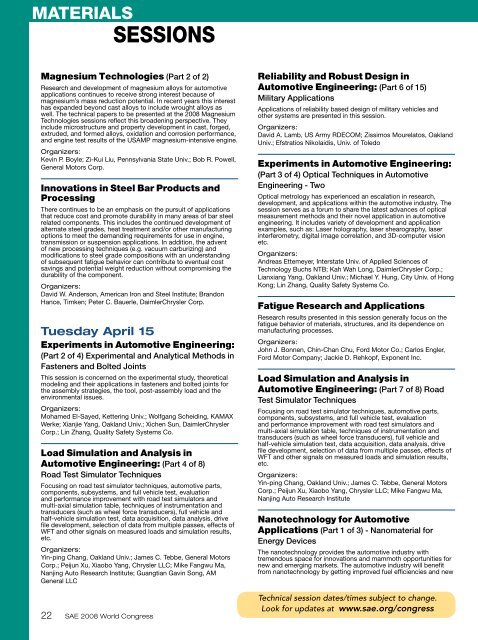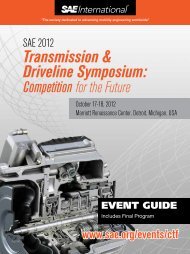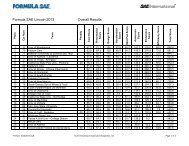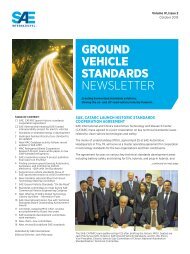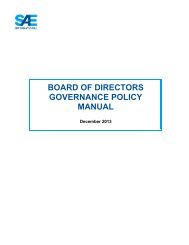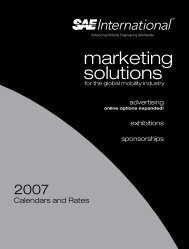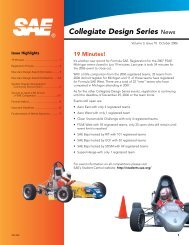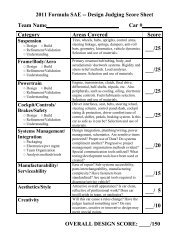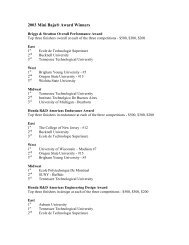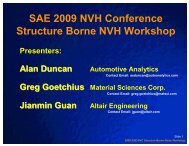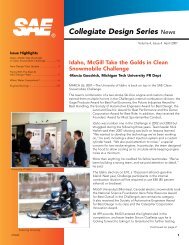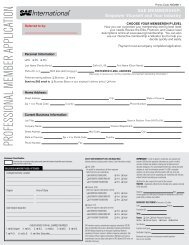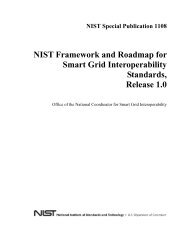Inspiring - SAE
Inspiring - SAE
Inspiring - SAE
You also want an ePaper? Increase the reach of your titles
YUMPU automatically turns print PDFs into web optimized ePapers that Google loves.
materials<br />
SESSIONS<br />
Magnesium Technologies (Part 2 of 2)<br />
Research and development of magnesium alloys for automotive<br />
applications continues to receive strong interest because of<br />
magnesium’s mass reduction potential. In recent years this interest<br />
has expanded beyond cast alloys to include wrought alloys as<br />
well. The technical papers to be presented at the 2008 Magnesium<br />
Technologies sessions reflect this broadening perspective. They<br />
include microstructure and property development in cast, forged,<br />
extruded, and formed alloys, oxidation and corrosion performance,<br />
and engine test results of the USAMP magnesium-intensive engine.<br />
Organizers:<br />
Kevin P. Boyle; Zi-Kui Liu, Pennsylvania State Univ.; Bob R. Powell,<br />
General Motors Corp.<br />
Innovations in Steel Bar Products and<br />
Processing<br />
There continues to be an emphasis on the pursuit of applications<br />
that reduce cost and promote durability in many areas of bar steel<br />
related components. This includes the continued development of<br />
alternate steel grades, heat treatment and/or other manufacturing<br />
options to meet the demanding requirements for use in engine,<br />
transmission or suspension applications. In addition, the advent<br />
of new processing techniques (e.g. vacuum carburizing) and<br />
modifications to steel grade compositions with an understanding<br />
of subsequent fatigue behavior can contribute to eventual cost<br />
savings and potential weight reduction without compromising the<br />
durability of the component.<br />
Organizers:<br />
David W. Anderson, American Iron and Steel Institute; Brandon<br />
Hance, Timken; Peter C. Bauerle, DaimlerChrysler Corp.<br />
Tuesday April 15<br />
Experiments in Automotive Engineering:<br />
(Part 2 of 4) Experimental and Analytical Methods in<br />
Fasteners and Bolted Joints<br />
This session is concerned on the experimental study, theoretical<br />
modeling and their applications in fasteners and bolted joints for<br />
the assembly strategies, the tool, post-assembly load and the<br />
environmental issues.<br />
Organizers:<br />
Mohamed El-Sayed, Kettering Univ.; Wolfgang Scheiding, KAMAX<br />
Werke; Xianjie Yang, Oakland Univ.; Xichen Sun, DaimlerChrysler<br />
Corp.; Lin Zhang, Quality Safety Systems Co.<br />
Load Simulation and Analysis in<br />
Automotive Engineering: (Part 4 of 8)<br />
Road Test Simulator Techniques<br />
Focusing on road test simulator techniques, automotive parts,<br />
components, subsystems, and full vehicle test, evaluation<br />
and performance improvement with road test simulators and<br />
multi-axial simulation table, techniques of instrumentation and<br />
transducers (such as wheel force transducers), full vehicle and<br />
half-vehicle simulation test, data acquisition, data analysis, drive<br />
file development, selection of data from multiple passes, effects of<br />
WFT and other signals on measured loads and simulation results,<br />
etc.<br />
Organizers:<br />
Yin-ping Chang, Oakland Univ.; James C. Tebbe, General Motors<br />
Corp.; Peijun Xu, Xiaobo Yang, Chrysler LLC; Mike Fangwu Ma,<br />
Nanjing Auto Research Institute; Guangtian Gavin Song, AM<br />
General LLC<br />
Reliability and Robust Design in<br />
Automotive Engineering: (Part 6 of 15)<br />
Military Applications<br />
Applications of reliability based design of military vehicles and<br />
other systems are presented in this session.<br />
Organizers:<br />
David A. Lamb, US Army RDECOM; Zissimos Mourelatos, Oakland<br />
Univ.; Efstratios Nikolaidis, Univ. of Toledo<br />
Experiments in Automotive Engineering:<br />
(Part 3 of 4) Optical Techniques in Automotive<br />
Engineering - Two<br />
Optical metrology has experienced an escalation in research,<br />
development, and applications within the automotive industry. The<br />
session serves as a forum to share the latest advances of optical<br />
measurement methods and their novel application in automotive<br />
engineering. It includes variety of development and application<br />
examples, such as: Laser holography, laser shearography, laser<br />
interferometry, digital image correlation, and 3D-computer vision<br />
etc.<br />
Organizers:<br />
Andreas Ettemeyer, Interstate Univ. of Applied Sciences of<br />
Technology Buchs NTB; Kah Wah Long, DaimlerChrysler Corp.;<br />
Lianxiang Yang, Oakland Univ.; Michael Y. Hung, City Univ. of Hong<br />
Kong; Lin Zhang, Quality Safety Systems Co.<br />
Fatigue Research and Applications<br />
Research results presented in this session generally focus on the<br />
fatigue behavior of materials, structures, and its dependence on<br />
manufacturing processes.<br />
Organizers:<br />
John J. Bonnen, Chin-Chan Chu, Ford Motor Co.; Carlos Engler,<br />
Ford Motor Company; Jackie D. Rehkopf, Exponent Inc.<br />
Load Simulation and Analysis in<br />
Automotive Engineering: (Part 7 of 8) Road<br />
Test Simulator Techniques<br />
Focusing on road test simulator techniques, automotive parts,<br />
components, subsystems, and full vehicle test, evaluation<br />
and performance improvement with road test simulators and<br />
multi-axial simulation table, techniques of instrumentation and<br />
transducers (such as wheel force transducers), full vehicle and<br />
half-vehicle simulation test, data acquisition, data analysis, drive<br />
file development, selection of data from multiple passes, effects of<br />
WFT and other signals on measured loads and simulation results,<br />
etc.<br />
Organizers:<br />
Yin-ping Chang, Oakland Univ.; James C. Tebbe, General Motors<br />
Corp.; Peijun Xu, Xiaobo Yang, Chrysler LLC; Mike Fangwu Ma,<br />
Nanjing Auto Research Institute<br />
Nanotechnology for Automotive<br />
Applications (Part 1 of 3) - Nanomaterial for<br />
Energy Devices<br />
The nanotechnology provides the automotive industry with<br />
tremendous space for innovations and mammoth opportunities for<br />
new and emerging markets. The automotive industry will benefit<br />
from nanotechnology by getting improved fuel efficiencies and new<br />
22<br />
<strong>SAE</strong> 2008 World Congress<br />
Technical session dates/times subject to change.<br />
Look for updates at www.sae.org/congress


